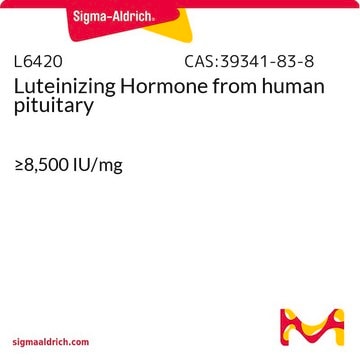07036
meso-2,6-Diaminopimelic acid
≥98% (TLC)
Synonym(s):
(2SR, 6RS)-2,6-Diaminoheptanedioic acid, meso-DAP
Sign Into View Organizational & Contract Pricing
All Photos(1)
About This Item
Empirical Formula (Hill Notation):
C7H14N2O4
CAS Number:
Molecular Weight:
190.20
Beilstein:
1726899
MDL number:
UNSPSC Code:
12352106
PubChem Substance ID:
NACRES:
NA.25
Recommended Products
Assay
≥98% (TLC)
form
powder
color
white to faint beige
application(s)
cell analysis
SMILES string
N[C@H](CCC[C@H](N)C(O)=O)C(O)=O
N[C@H](CCC[C@H](N)C(O)=O)C(O)=O
InChI
1S/C7H14N2O4/c8-4(6(10)11)2-1-3-5(9)7(12)13/h4-5H,1-3,8-9H2,(H,10,11)(H,12,13)/t4-,5+
InChI key
GMKMEZVLHJARHF-SYDPRGILSA-N
Related Categories
Application
Meso-2,6-diaminopimelic acid may be used to study peptidoglycan structure and function within the cell walls of bacteria.
Biochem/physiol Actions
Penultimate biosynthetic precursor of the essential amino acid L-lysine. Component of peptidoglycan in the cell wall of many bacteria.
Packaging
Bottomless glass bottle. Contents are inside inserted fused cone.
Storage Class Code
11 - Combustible Solids
WGK
WGK 3
Flash Point(F)
Not applicable
Flash Point(C)
Not applicable
Choose from one of the most recent versions:
Already Own This Product?
Find documentation for the products that you have recently purchased in the Document Library.
Luigi Franchi et al.
Cellular microbiology, 10(1), 1-8 (2007-10-20)
The innate immune system comprises several classes of pattern-recognition receptors, including Toll-like receptors (TLRs) and nucleotide binding and oligomerization domain-like receptors (NLRs). TLRs recognize microbes on the cell surface and in endosomes, whereas NLRs sense microbial molecules in the cytosol.
S Satyanarayana et al.
Amino acids, 21(3), 221-235 (2002-01-05)
Peptidoglycans isolated from two Fusobacterium species of anaerobic bacteria were analyzed for constituent amino acids. Hydrolysis conditions were varied to optimize the yield of diamino acids from peptidoglycan. The o-phthalaldehyde derivatives of the diamino acid stereoisomers were separated by high-performance
Diaminopimelate and lysine.
Patte, J. C.
Amino Acids: Biosynthesis and Genetic Regulation, 3, 213-228 (1983)
J McKerrow et al.
Letters in applied microbiology, 30(3), 178-182 (2000-04-04)
A simple and sensitive method for separating and detecting the LL, DD and meso diastereomers of the dibasic amino acid diaminopimelic acid (DAP) in the peptidoglycan of Gram-positive bacteria is described. This method is based on reverse phase HPLC separation
Chiral high-performance liquid chromatographic separation of the three stereoisomers of 2,6-diaminopimelic acid without derivatization.
Nagasawa, T., et al.
Journal of Chromatography A, 653, 336-340 (1993)
Our team of scientists has experience in all areas of research including Life Science, Material Science, Chemical Synthesis, Chromatography, Analytical and many others.
Contact Technical Service







